
Cardinal flower
--LSU AgCenter/Dan Gill
Get It Growing: Try native plants in the landscape
Native plants are not used as much as they could be in our landscapes. While natives cannot satisfactorily replace all of the many types of plants we use, incorporating native plants when and where we can is a good thing.
The best reason to use native plants is that they give our landscapes a sense of place. Using plants native to your region links your landscape to natural areas and the plants they contain. It makes the gardens here in the Gulf Coast South look distinctively different than gardens in other parts of the country.
Native plants also bring interest, natural beauty and diversity to the landscape. The repeated planting of a few popular landscape plants everywhere tends to create monotony.
Also, native plants can play an important role in providing food for native wildlife and restoring habitat. Wildlife will generally feed on nonnative plants. But native birds and insects have coexisted with native plants for hundreds of years and are especially adapted to feeding on native foliage, nectar and fruit.
Native plants are also well adapted to the climate of their native region — think temperatures and rainfall — and are generally tolerant of common pest problems.
Finally, many gardeners simply get a sense of satisfaction by using native plants, and we enjoy the beauty they provide.
This is a good point to stop and think about what we mean by the term “native plant.” In the strictest sense of the word, it would refer to the plants that grow naturally in the specific locality where you live and garden. I especially favor plants that are native to Louisiana; however, I’m generally satisfied if the plant is native to the Gulf Coast region from Texas to Florida.
I often hear it said that natives are lower-maintenance, don’t get insect and disease problems and are tougher and more reliable than nonnatives. I think this idea is sometimes presented too forcefully.
Natives are not necessarily easier to grow or more reliable than introduced plants. A plant will not thrive in your landscape just because it’s a native. As with all plants, to be successful you must match the growing conditions a native plant needs to the growing conditions where you plant it. Some natives can be quite finicky about their growing conditions. So even if a plant is a native, you will fail with it unless you have a place in your landscape that makes it happy.
As for pest problems, native plants have their share. Although native plants generally survive pest attacks and recover without treatment, gardeners may still be unhappy when they are looking at a plant whose leaves are unattractively chewed up by native bugs or spotted by a native fungus.
For me, using natives in the landscape comes down to the three A’s — appearance, adaptability and availability.
Appearance: A native plant must generally be attractive to us in some way to make us want to grow it in our landscapes. Many native trees and shrubs produce showy flowers or fruit.
Some may simply provide nice green foliage or an interesting texture in the landscape. There are lots of nondescript natives out there that few, if any, gardeners would want in their landscapes.
Adaptability: Our landscapes often present plants with rather harsh environments — particularly in newer subdivisions. Natives that have been most successfully incorporated into landscapes are not overly fussy about growing condition and are able to adapt to a wide variety of situations. The dwarf yaupon holly (Ilex vomitoria dwarf cultivars) is an excellent example of this. Remember, when using natives, choose those that are adapted to the growing conditions that exist in your landscape.
Availability: It doesn’t matter how wonderful a native plant is if you cannot find it. If it is not being propagated and grown by wholesale nurseries and if retail garden centers don’t carry it, then it will be hard to find.
To become available to the gardening public, a native needs to be relatively easy to propagate commercially and amenable to being produced in containers by wholesale growers. A native plant that is difficult to propagate successfully and will not grow well in container production will never become widely available.
Retail nurseries are notoriously bad about not carrying native plants — even when they may be available from wholesale growers. There are good reasons. There is generally little demand for native plants from the average person shopping at the nursery. Nurseries are businesses and tend to carry what sells best. But they will respond to demand.
Ask a staff member to show you their native plants. If they don’t have a native you would like to plant, always make the nursery manager or owner aware of what you are looking for. If enough people ask for a native plant, they will be more likely to carry it.
Some of the natives you may find include American fringe tree, cross vine, nuttall oak, cardinal flower, honeysuckle azalea, oakleaf hydrangea, coral honeysuckle, Indian pink, parsley hawthorn, red buckeye, yellow jessamine, river birch, Virginia willow, sweet bay magnolia, dwarf palmetto and dwarf yaupon.
As you think about adding trees, shrubs, ground covers and vines to your landscape, always look to see if there are some suitable native options. And when a non-native and a native plant are equally suitable — go native.
- Log in to post comments
